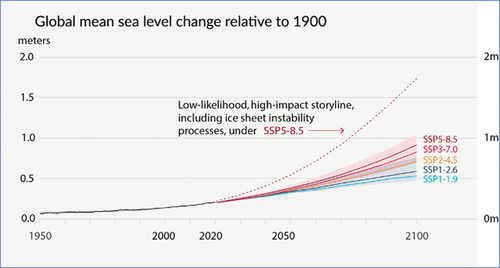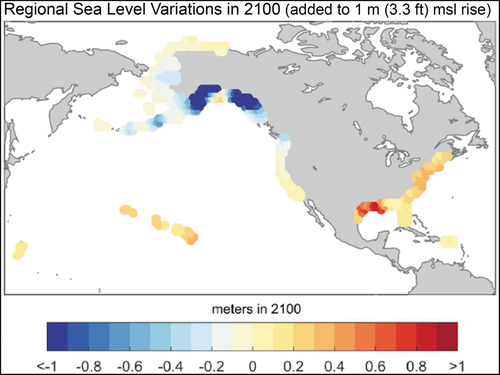THE ISSUE
Rising sea level is a direct consequence of our warming climate. Increasing rates of warming have doubled the rate of sea level rise in the past 100 years, and this in turn has greatly increased the occurrence of coastal flooding.
Figure 1. Historical sea level data through 2020 and estimated future sea level rise (with 'likely' confidence ranges). Projections and ranges are shown for the IPCC AR6 SSP1-2.6 (blue) and SSP3-7.0 (red) scenarios, with additional story-lines.Citation3

Figure 2. Projected regional sea level change for 2100 (in meters from year 2000 levels) for U.S. coasts relative to a mean rise everywhere of 1 m (figure 13 in Sweet et al.Citation5).

WHY IT MATTERS
Flooding is the most common and most expensive natural disaster.Citation1 Sea level increases tend to be gradual but serve as the base level for storm surges, tides, and waves, allowing them to drive water farther inland, increasing damage to ecosystems and coastal infrastructure and threatening human life.
STATE OF KNOWLEDGE
Sea level has been rising since the end of the last ice age (~20,000 years ago). During periods of rapid ice sheet loss, sea level rose in excess of 40 mm/year.Citation2 During the twentieth century, the rate averaged 1.5 (1.1–1.9) mm/year, due primarily to warming of the upper ocean (thermal expansion) but with a contribution from glacier loss.Citation3,Citation4 More recently, the rate of sea level rise has increased to a present value of about 3.7 ± 0.5 mm/yr (2006–2018), mostly due to increasing losses from glaciers and the Greenland Ice Sheet ().Citation3–6 The globally averaged rate of sea level rise is projected to continue to increase as the oceans continue to warm and glaciers and ice sheets shrink faster. Estimates of globally averaged sea level by 2100 are 0.44 to 1.01 m higher than the average during 1986 to 2005, depending on the actual emissions of greenhouse gases by continued global economic development.Citation3–6 Sea level increases in this range will cause extensive damage in the United States, particularly along the Atlantic, Gulf, and northern Alaskan coasts. Moreover, a significant possibility exists that actual sea level rise will exceed these estimates due to ice–climate interactions not fully included in models.Citation3
Local changes of sea level can differ markedly from these globally averaged rates ().Citation5 Three major contributors to sea level underlie these local variations, each of which have unique geographic variability. Warming of the ocean is causing the water to expand and, thus, sea level to rise; however, warming rates and ocean layer thicknesses vary. Changes in surface winds and the exchange of heat and freshwater between the air and ocean change ocean circulation and therefore regional sea level. As warmer temperatures both melt more ice and increase ice flow into the ocean, loss of land ice (e.g., glaciers and the Greenland and Antarctic Ice Sheets) increases the mass of the oceans. These large changes in the distribution of water change the Earth’s gravitational field and the surface load on the Earth’s surface. The resulting movement of the Earth’s crust, as well as other tectonic movements of the Earth’s surface, change sea level in the ocean relative to the land. Though a partial response to these mass changes is immediate, the full effect can take thousands of years to fully emerge and spread across the globe. These factors are interrelated, requiring a more complex integrated research analysis. Secondary effects, such as long-term changes in atmospheric pressure, also can impact regional sea level.
Coastal flooding and inundation are driven more directly by severe storms and tsunamis. The frequency of extreme events is more difficult to project; nevertheless, higher sea level leads directly to more frequent flooding occurrence by providing a higher base level. The likelihood of floods of a particular height will increase as sea level rises, but these probabilities should be regarded as underestimates until the increased frequency of storms of a particular strength can be quantified.
WHERE THE SCIENCE IS HEADED
Though there is no doubt sea level has been and is rising and will continue to rise through this century, each contributing factor discussed above also contributes some degree of uncertainty that scientists are striving to minimize. Ice loss is now the largest contributor but also is the most uncertain, particularly on the side of sudden, rapid increases in sea level. Past episodes of rapid ice sheet collapse, driven by the action of warm water on the ice sheet edge, raise the specter of unseen surprises. Research at the ice sheet edge is expensive and risky and requires many years to provide a solid understanding of ice–ocean interactions and inform predictions. Vertical land motion and thermal expansion contribute far less uncertainty due to their gradual nature.
The dependence of coastal flooding on future storm frequency and intensity provides additional challenges. Improved prediction of storm frequency is a prerequisite for assessing increased vulnerability of coastal areas.
Supplemental Material
Download Zip (172.2 KB)Disclosure statement
No potential conflict of interest was reported by the author(s).
Supplemental material
Supplemental material for this article can be accessed on the publisher’s website.
Additional information
Funding
Key references
- Hinkel, J., D. Lincke, A. T. Vafeidis, M. Perrette, R. J. Nicholls, R. S. Tol, B. Marzeion, X. Fettweis, C. Ionescu, A. Levermann. “Coastal flood damage and adaptation costs under 21st century sea-level rise,” Proceedings of the National Academy of Sciences 111, no. 9 (2014): 3292–3297. https://doi.org/10.1073/pnas.1222469111 .
- Cronin, T. M. “Rapid sea-level rise,” Quaternary Science Reviews 56(2012): 11–30. https://doi.org/10.1016/j.quascirev.2012.08.021 .
- Intergovernmental Panel on Climate Change, “Summary for Policymakers,” in IPCC Special Report on the Ocean and Cryosphere in a Changing Climate, ed. H.-O. Pörtner, D.C. Roberts, V. Masson-Delmotte, P. Zhai, M. Tignor, E. Poloczanska, K. Mintenbeck, A. Alegría, M. Nicolai, A. Okem, J. Petzold, B. Rama, and N.M. Weyer (Cambridge, UK: Cambridge University Press, 2019), pp. 3–35. https://doi.org/10.1017/9781009157964.001 .
- Nerem, R. S., B. D. Beckley, J. T. Fasullo, B. D. Hamlington, D. Masters, and G. T. Mitchum. “Climate-change– driven accelerated sea-level rise detected in the altimeter era,” Proceedings of the National Academy of Sciences, 115, no. 9 (2018): 2022–2025. doi:10.1073/pnas.1717312115.
- Sweet, W.V., R.E. Kopp, C.P. Weaver, J. Obeysekera, R.M. Horton, E.R. Thieler, C. Zervas. “Global and Regional Sea Level Rise Scenarios for the United States,” (NOAA Technical Report NOS CO-OPS 083, NOAA, January 2017).
- Third National Climate Assessment, Sea Level Section (accessed March 30, 2022), http://nca2014.globalchange.gov/report/our-changing-climate/sea-level-rise.
